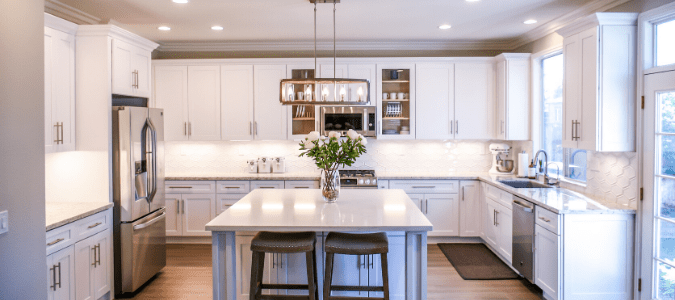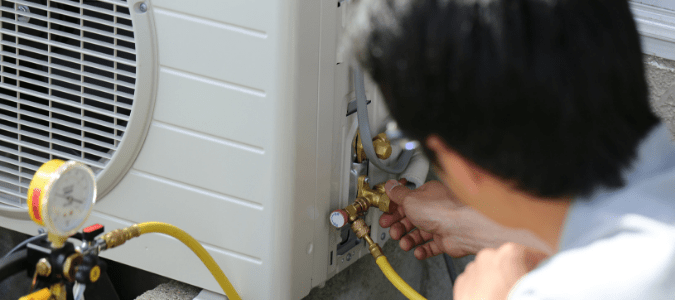A working furnace is a vital part of any home, even in warmer states like Texas. The last thing you want is to have a malfunctioning furnace in the dead of winter. If your furnace is reaching the end of its life, you’ll want to reach out to a heating specialist. A heating specialist knows all the calculations and factors that must be considered before making a large purchase like this one.
While some homeowners may think the bigger the better, this isn’t always the case. A furnace that is too big will also work too hard, which results in skyrocketing energy bills. On the other hand, a furnace that is too small will not heat your home completely, leaving you cold in the winter. Plus, it will have a shorter lifespan since it is working overtime to produce enough heat.
So, what do heating specialists look at when determining what size furnace will be best for your home?
How Heating Specialists Determine the Right Sized Furnace
The size of a furnace depends on two things: the square footage of your house and how much heat a furnace produces per hour. This measurement doesn’t have much to do with the physical size of the furnace. The more important measurement is British thermal units (BTUs). This unit measures how much energy is needed to heat a pound of water, and it calculates the temperature in Fahrenheit.
Before suggesting a furnace, your specialist will determine how many BTUs per hour you need to heat your home. Most heating experts recommend between 30 and 60 BTUs for every square foot of your home. The climate where you live determines whether your home is on the low or high end of that range.
The United States has five different climate zones, and Texas is in zone one. The recommended heating factor for zone one homes is 30 to 35 BTU per square foot.
The most common furnace size produces between 80,000 and 100,000 BTUs per hour, making it suitable for most family homes. A heating expert can help you choose the right type of furnace for your home.
Other Factors Specialists Consider Before Suggesting a Furnace
Beyond the size of your furnace, there are many criteria heating specialists take into account before making a suggestion. One consideration is energy efficiency. Energy-efficient furnaces cost more upfront, but they save you money on your monthly heating bill. A furnace with a programmable thermostat will also save you money each month.
The stage or burner type of your furnace is another key factor to consider. A modulating burner will keep you the most comfortable, and it is the most energy-efficient option. Single-stage and dual-stage furnaces, on the other hand, give you less freedom and use more energy.
The furnace blower also impacts how comfortable your home feels in the winter, and there are three options out there. A single-speed blower is the least flexible and efficient option. A multi-speed blower that operates at low, medium and high capacity is a better option. However, the most efficient option is the variable speed blower, which allows you to make even smaller speed adjustments to fine-tune your comfort.
Furnaces should last for 15 to 20 years, so your heating specialist will inform you of warranty programs. They can also let you know if your local utility company offers incentives on high-efficiency furnaces.
Finally, your new furnace must be installed correctly so that it performs at full capacity. Your heating specialist can handle everything from an inspection to installation for you. Many heating repair companies offer complimentary home inspections to recommend the best furnace for you and your family.
Why is Your Furnace Not Kicking On?
No one wants to be in a cold house in the dead of winter with a furnace that’s won’t ignite. How do you know when it needs repairing and when it’s time to fully replace it?
When your furnace is not kicking on, the first thing to check is your thermostat. Make sure it is set to heating and that the temperature on the thermostat is lower than your home’s temperature. If your furnace still isn’t coming on, your thermostat could be internally damaged.
If there are no problems with your thermostat, check your fuse box. Look for signs that your fuse tripped or an electrical shortage appeared, such as burn marks on your fuse box.
If there aren’t issues with your thermostat or your fuse box, you should contact a specialist. Any additional inspection or repairs should only be handled by a licensed professional.
Your professional will likely check the furnace’s condensation plate. The furnace can not kick on when the plate is full, which may signal that your furnace’s pump has lost power or there are pipe blockages. Another potential culprit could be the furnace blower. If your furnace has an inspection window, you can tell there is a problem with the blower when the inspection light turns red or does not come on. Finally, your furnace’s pilot light may be out.
A heating repair company can inspect your thermostat, fuse box and furnace for you and repair the problem.
The Average Life of a Furnace
The average furnace should last between 15 and 20 years. Having the correct size furnace will help you get the most out of your system.
How you set your thermostat also impacts how long a furnace can last. Setting it too low or too high regularly will make your furnace work harder, which reduces its lifespan. To help it last for up to two decades, The U.S. Department of Energy recommends keeping your thermostat at 68 degrees Fahrenheit during the winter.
The best way to guarantee that your furnace has a long life is with regular maintenance checks. A heating and air conditioning specialist can perform routine checks on your furnace to catch problems before they become major nightmares. Signing up for a regular maintenance schedule with your HVAC expert will put your mind at ease and keep your furnace running properly for years.
The ideal furnace tune-up schedule is once a year. However, in warmer climates, some heating specialists will schedule them up to two years apart. Older furnaces may need servicing more often to avoid problems.
It is also recommended that homeowners have their air ducts cleaned every few years to protect their furnaces and keep the air in their homes healthy. This is especially important if you have pets or allergies.
Another part of keeping your furnace in tip-top shape is maintaining clean air filters for optimal airflow. Clogged air flow will make your furnace work harder, leading to costly repairs. You should change your air filters every three months or sooner if you notice they are dirty.
Maintaining your home’s insulation is another important part of furnace maintenance. When heat constantly escapes from your home and cold air gets in, your furnace has to work much harder to keep your home warm. Before winter sets in, inspect your home for cracks and holes. Seal up any areas where cold air could sneak in, such as your windows and doors.
Other common spots for air to leak out of your home include your duct register, attic hatch and plumbing vent stack. Cold air can get into your home easily through openings in your dryer vent, outdoor faucet, vent fan and other areas. A heating specialist will inspect your home’s insulation during a furnace tune-up. But, it’s a good idea to stay on top of leaks and holes.
When your furnace is running smoothly, you barely have to think about it and you can enjoy a warm house in the winter. Keeping up with regular furnace tune-ups will make your life easier, save you money and keep your home comfortable all winter.
Keep Your Home Warm All Winter
The more you know about your home’s heating system, the more comfortable you and your family will be throughout the winter. Purchasing a furnace that is the right size will keep your monthly costs down and limit the need for repairs.
Contact a heating repair company to do a complimentary inspection of your home. They will help you pick out the right furnace and install it properly. After that, you should sign up for a routine furnace maintenance schedule to keep your furnace in working order. Don’t wait until your furnace breaks to call a professional.
ABC Can Make Your Home Comfortable Again
Without a functioning heater or air conditioner, the members of your household can quickly get uncomfortable. If you’re having issues with your unit, contact ABC Home & Commercial Services. We can make HVAC system repairs, provide preventative maintenance and can even offer honest advice on when to replace your air conditioner.



